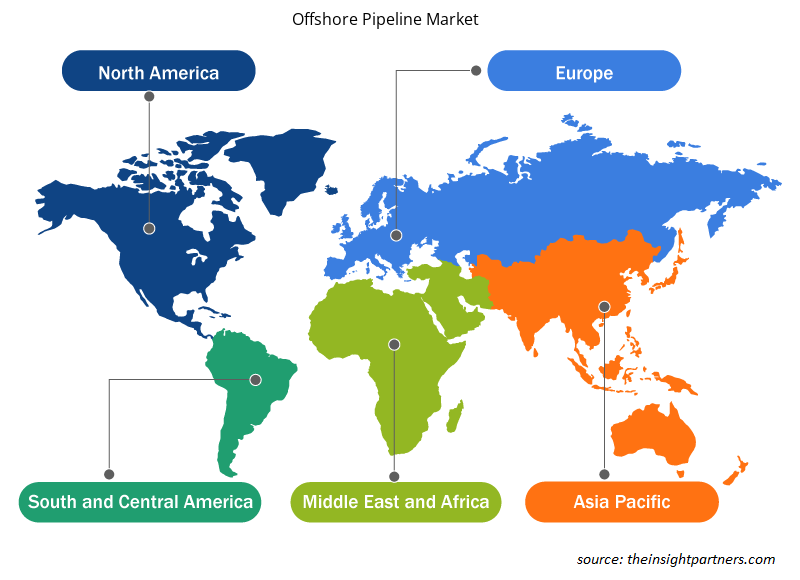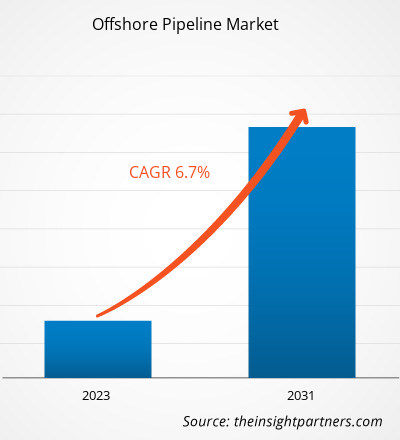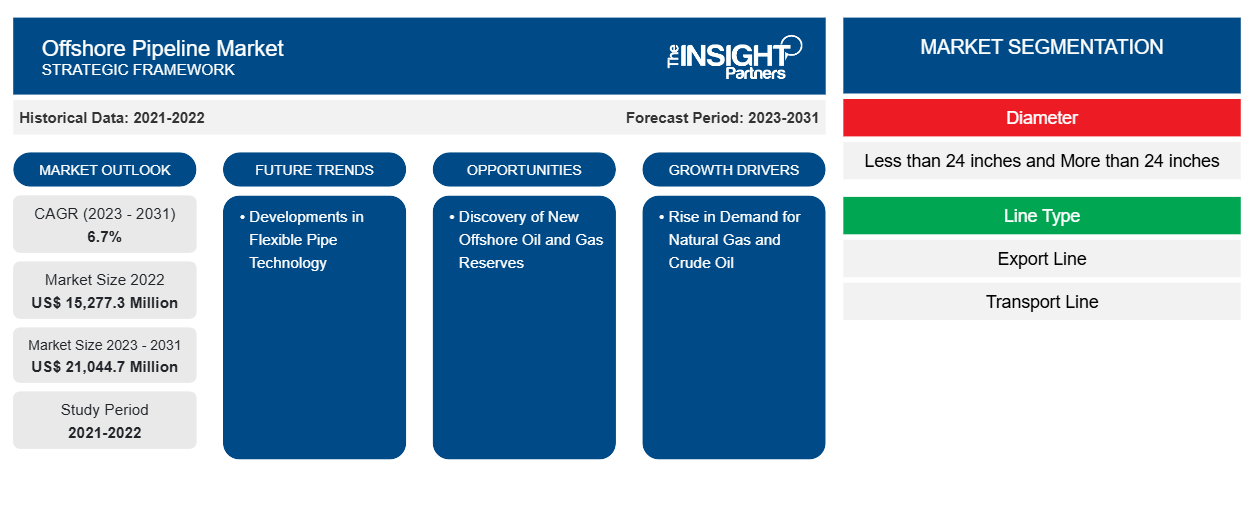من المتوقع أن يصل حجم سوق خطوط الأنابيب البحرية إلى 21.044.7 مليون دولار أمريكي بحلول عام 2031 من 15.277.3 مليون دولار أمريكي في عام 2022. ومن المتوقع أن يسجل السوق معدل نمو سنوي مركب بنسبة 6.7٪ خلال الفترة 2023-2031. تعد زيادة إنتاج النفط والغاز البحري، وارتفاع إنتاج منصات النفط الجديدة، وإعادة بناء منصات النفط والغاز البحرية الحالية والقديمة من بين العوامل الرئيسية التي تدفع سوق خطوط الأنابيب البحرية.
تحليل سوق خطوط الأنابيب البحرية
ومن المتوقع أن يشهد سوق خطوط الأنابيب البحرية نموًا كبيرًا نظرًا للعدد المتزايد من مشاريع الغاز الطبيعي بالإضافة إلى اكتشاف حقول نفط جديدة، وخاصة في المواقع النائية. بالإضافة إلى ذلك، أدى استنفاد احتياطيات النفط والغاز الحالية في مختلف البلدان إلى خلق طلب على خطوط الأنابيب عبر الحدود لتوريد المنتجات المرتبطة بالنفط والغاز، مما يعزز نمو سوق خطوط الأنابيب البحرية. كما أن الطلب المتزايد على طرق النقل الفعالة من حيث التكلفة للنفط والغاز هو أيضًا أحد العوامل الرئيسية التي من المتوقع أن تعزز الطلب على خطوط الأنابيب البحرية في قطاع النفط والغاز في جميع أنحاء العالم.
نظرة عامة على سوق خطوط الأنابيب البحرية
لقد أدى الانفجار السكاني والتصنيع المصاحب له إلى زيادة الطلب على الطاقة على المستوى العالمي. وقد أدى ارتفاع استهلاك الطاقة إلى تعزيز الحاجة إلى النفط والغاز في الاقتصادات النامية والمتقدمة. وقد أدى ذلك إلى دفع الطلب على البنية الأساسية لخطوط الأنابيب البحرية في جميع أنحاء العالم. تعد منطقة آسيا والمحيط الهادئ أكبر مستهلك للنفط الخام والغاز. علاوة على ذلك، أفادت البلدان الصناعية للغاية في منطقة آسيا والمحيط الهادئ، بما في ذلك الصين والهند واليابان وكوريا الجنوبية، بزيادة استهلاك الطاقة الإجمالي. إن تركيزها على تعزيز إنتاج النفط المحلي من خلال تقنيات مختلفة لاستخراج النفط المعزز يعزز سوق خطوط الأنابيب البحرية في منطقة آسيا والمحيط الهادئ لتلبية الطلب المتزايد على النفط.
قم بتخصيص هذا التقرير ليناسب متطلباتك
ستحصل على تخصيص لأي تقرير - مجانًا - بما في ذلك أجزاء من هذا التقرير، أو تحليل على مستوى الدولة، وحزمة بيانات Excel، بالإضافة إلى الاستفادة من العروض والخصومات الرائعة للشركات الناشئة والجامعات
-
احصل على أهم اتجاهات السوق الرئيسية لهذا التقرير.ستتضمن هذه العينة المجانية تحليلاً للبيانات، بدءًا من اتجاهات السوق وحتى التقديرات والتوقعات.
محركات وفرص سوق خطوط الأنابيب البحرية
تزايد الطلب على الغاز الطبيعي والنفط الخام
يشهد الطلب على النفط والغاز الطبيعي زيادة مستمرة في جميع أنحاء العالم. وقد سجلت الولايات المتحدة والصين أكبر نمو ملحوظ. كما أن الارتفاع في الإنتاج الصناعي، إلى جانب الطلب المرتفع على خدمات النقل بالشاحنات، يعزز الطلب على البتروكيماويات، وبالتالي يغذي نمو سوق خطوط الأنابيب البحرية. وعلاوة على ذلك، فإن النمو في أحجام الحركة الجوية في جميع أنحاء العالم، وخاصة في آسيا، هو عامل مهم آخر يؤدي إلى زيادة استهلاك النفط.fuelling the growth of the offshore pipeline market. Moreover, the growth in air traffic volumes worldwide, particularly in Asia, is another significant factor resulting in increased oil consumption.
نشرت منظمة الدول المصدرة للبترول (أوبك) "توقعات أوبك العالمية للنفط لعام 2020" في أكتوبر 2020. ووفقًا للتوقعات، أدت جائحة كوفيد-19 إلى انخفاض الطلب على النفط؛ ومع ذلك، كان من المتوقع أن يسجل الطلب العالمي على الطاقة نموًا ثابتًا في المستقبل، حيث سيرتفع بنسبة ملحوظة تبلغ 25٪ بحلول عام 2045. وتتوقع التوقعات أيضًا أن يكون النفط هو المساهم الأكبر في سوق مزيج الطاقة، حيث سيساهم بنسبة 27٪ من إجمالي حصة الطاقة بحلول عام 2045. ومن المتوقع أن يرتفع الطلب على المنتجات النفطية بأكثر من ~47 مليون برميل يوميًا خلال الفترة 2022-2025 في دول منظمة التعاون الاقتصادي والتنمية. من ناحية أخرى، من المتوقع أن يرتفع الطلب في الدول غير الأعضاء في منظمة التعاون الاقتصادي والتنمية بمقدار 22.5 مليون برميل يوميًا خلال الفترة المتوقعة.OECD countries. On the other hand, the demand in non-OECD countries is projected to rise by 22.5 MB/day during the forecast period.
جهود مستمرة لتحسين عمليات استخراج النفط
تستثمر بلدان مختلفة في تجديد مواردها النفطية الحالية من أجل تعزيز إنتاج النفط المحلي وتقليل اعتمادها على واردات النفط. وعلى مدى العقود الأخيرة، تم استغلال طريقة حقن البخار تجاريًا لتحسين الاستخراج من خزانات النفط الثقيل التقليدية في مراحلها اللاحقة من التطوير. يزيد البخار المحقون من الضغط الكلي لخزان النفط البحري، مما يساعد على تحسين نسبة تنقل النفط الخام ويسمح له بالتدفق بكفاءة. ونتيجة لذلك، تساعد طرق استخراج النفط المحسنة في تنشيط عمليات الاستخراج في آبار النفط البحرية الحالية. وبالتالي، من المتوقع أن يوفر توسع عمليات النفط والغاز فرص نمو واعدة للاعبين في سوق خطوط الأنابيب البحرية في السنوات القادمة.
تقرير تحليل تجزئة سوق خطوط الأنابيب البحرية
إن القطاعات الرئيسية التي ساهمت في استخلاص تحليل سوق خطوط الأنابيب البحرية هي النوع والمستخدم النهائي.
- بناءً على القطر، تم تقسيم سوق خطوط الأنابيب البحرية إلى خطوط أنابيب أقل من 24 بوصة وخطوط أنابيب أكثر من 24 بوصة. واستحوذت شريحة خطوط الأنابيب التي يقل قطرها عن 24 بوصة على حصة سوقية أكبر في عام 2023.
- بحسب نوع الخط، يتم تقسيم سوق خطوط الأنابيب البحرية إلى خطوط النقل وخطوط التصدير وغيرها. وقد احتل قطاع خطوط النقل الحصة الأكبر في السوق في عام 2023.
- من حيث المنتجات، ينقسم السوق إلى النفط والغاز والمنتجات المكررة. وسيسيطر قطاع المنتجات المكررة على السوق في عام 2023.
تحليل حصة سوق خطوط الأنابيب البحرية حسب المنطقة الجغرافية
ينقسم النطاق الجغرافي لتقرير سوق خطوط الأنابيب البحرية بشكل أساسي إلى خمس مناطق: أمريكا الشمالية وأوروبا وآسيا والمحيط الهادئ والشرق الأوسط وأفريقيا وأمريكا الجنوبية والوسطى.
سيطرت أوروبا على سوق خطوط الأنابيب البحرية في عام 2023. وتنقسم السوق في أوروبا إلى ألمانيا والنرويج وإيطاليا وروسيا والمملكة المتحدة وبقية أوروبا. تعد أوروبا ثاني أكبر منتج للمنتجات البترولية على مستوى العالم، حيث تحتفظ بطاقة تكرير النفط بأكثر من 15٪. وقد شهدت صناعة الغاز في أوروبا تحولات مختلفة بسبب الطلب المتزايد على الغاز الطبيعي المسال. علاوة على ذلك، لا تزال النرويج وروسيا تحافظان على مكانتهما كموردين للغاز الطبيعي، في حين تعد ألمانيا وفرنسا وإيطاليا المستوردين الرئيسيين للغاز الطبيعي. وبالتالي، فإن العدد المتزايد من مشاريع الغاز الطبيعي، فضلاً عن اكتشاف حقول نفطية جديدة، وخاصة في المواقع النائية، من المرجح أن يؤدي إلى تسريع الطلب على أنظمة وخدمات خطوط الأنابيب البحرية.
رؤى إقليمية حول سوق خطوط الأنابيب البحرية
لقد قام المحللون في Insight Partners بشرح الاتجاهات والعوامل الإقليمية المؤثرة على سوق خطوط الأنابيب البحرية طوال فترة التوقعات بشكل شامل. يناقش هذا القسم أيضًا قطاعات سوق خطوط الأنابيب البحرية والجغرافيا في جميع أنحاء أمريكا الشمالية وأوروبا ومنطقة آسيا والمحيط الهادئ والشرق الأوسط وأفريقيا وأمريكا الجنوبية والوسطى.

- احصل على البيانات الإقليمية المحددة لسوق خطوط الأنابيب البحرية
نطاق تقرير سوق خطوط الأنابيب البحرية
| سمة التقرير | تفاصيل |
|---|---|
| حجم السوق في عام 2022 | 15,277.3 مليون دولار أمريكي |
| حجم السوق بحلول عام 2031 | 21,044.7 مليون دولار أمريكي |
| معدل النمو السنوي المركب العالمي (2023 - 2031) | 6.7% |
| البيانات التاريخية | 2021-2022 |
| فترة التنبؤ | 2023-2031 |
| القطاعات المغطاة |
حسب القطر
|
| المناطق والدول المغطاة |
أمريكا الشمالية
|
| قادة السوق وملفات تعريف الشركات الرئيسية |
|
كثافة اللاعبين في سوق خطوط الأنابيب البحرية: فهم تأثيرها على ديناميكيات الأعمال
يشهد سوق خطوط الأنابيب البحرية نموًا سريعًا، مدفوعًا بالطلب المتزايد من المستخدم النهائي بسبب عوامل مثل تفضيلات المستهلكين المتطورة والتقدم التكنولوجي والوعي المتزايد بفوائد المنتج. ومع ارتفاع الطلب، تعمل الشركات على توسيع عروضها والابتكار لتلبية احتياجات المستهلكين والاستفادة من الاتجاهات الناشئة، مما يؤدي إلى زيادة نمو السوق.
تشير كثافة اللاعبين في السوق إلى توزيع الشركات أو المؤسسات العاملة في سوق أو صناعة معينة. وهي تشير إلى عدد المنافسين (اللاعبين في السوق) الموجودين في مساحة سوق معينة نسبة إلى حجمها أو قيمتها السوقية الإجمالية.
الشركات الرئيسية العاملة في سوق خطوط الأنابيب البحرية هي:
- شركة إنبريدج
- شركة سايبم
- شركة ماكديرموت الدولية المحدودة
- مجموعة أولسياس
- شركة هندسة خطوط الأنابيب البترولية الصينية المحدودة
- كيندر مورجان
إخلاء المسؤولية : الشركات المذكورة أعلاه ليست مرتبة بأي ترتيب معين.

- احصل على نظرة عامة على أهم اللاعبين الرئيسيين في سوق خطوط الأنابيب البحرية
أخبار سوق خطوط الأنابيب البحرية والتطورات الأخيرة
يتم تقييم سوق خطوط الأنابيب البحرية من خلال جمع البيانات النوعية والكمية بعد البحث الأولي والثانوي، والذي يتضمن منشورات الشركات المهمة وبيانات الجمعيات وقواعد البيانات. فيما يلي بعض التطورات في سوق خطوط الأنابيب البحرية:
- في يوليو 2023، قامت شركة كيندر مورجان وشركتا هوارد إنيرجي بارتنرز بتوسيع أنظمة نقل الغاز الطبيعي في إيجل فورد. وتقوم شركة تيجاس ببناء خط أنابيب بطول 67 ميلاً، وتقوم شركة دوس كامينوس ببناء خط أنابيب بطول 62 ميلاً. ومن المتوقع أن يكتمل المشروعان في الربع الرابع من عام 2023 وأن يسلما ما يصل إلى 2 مليار قدم مكعب يوميًا من الغاز الطبيعي إلى أسواق ساحل الخليج الأمريكي. ويشكل مشروع التوسعة الذي تبلغ تكلفته 251 مليون دولار أمريكي رابط إمداد بالغ الأهمية لمولدات الطاقة والعملاء الصناعيين ومصدري الغاز الطبيعي المسال على طول شبكة خطوط الأنابيب داخل الولاية في تكساس.
- في فبراير 2023، وقعت شركة إيناجاس اتفاقية مع شركة ريجانوسا، دفعت بموجبها إيناجاس 54 مليون يورو لشركة ريجانوسا لشراء شبكة من خطوط أنابيب الغاز الطبيعي بطول 130 كيلومترًا. ويعتمد التشغيل الفعال وأمن إمدادات سوق الغاز الأيبيرية على هذه الشبكة.
تقرير سوق خطوط الأنابيب البحرية والتغطية والنتائج المتوقعة
يوفر تقرير "حجم سوق خطوط الأنابيب البحرية والتوقعات (2021-2031)" تحليلاً مفصلاً للسوق يغطي المجالات التالية:
- حجم سوق خطوط الأنابيب البحرية وتوقعاتها على المستويات العالمية والإقليمية والوطنية لجميع قطاعات السوق الرئيسية التي يغطيها النطاق
- اتجاهات سوق خطوط الأنابيب البحرية بالإضافة إلى ديناميكيات السوق مثل المحركات والقيود والفرص الرئيسية
- تحليل مفصل لقوى PEST/Porter الخمس وSWOT
- تحليل سوق خطوط الأنابيب البحرية يغطي اتجاهات السوق الرئيسية والإطار العالمي والإقليمي والجهات الفاعلة الرئيسية واللوائح والتطورات الأخيرة في السوق
- تحليل المشهد الصناعي والمنافسة الذي يغطي تركيز السوق، وتحليل خريطة الحرارة، واللاعبين البارزين، والتطورات الأخيرة لسوق خطوط الأنابيب البحرية
- ملفات تعريف الشركة التفصيلية
- التحليل التاريخي (سنتان)، سنة الأساس، التوقعات (7 سنوات) مع معدل النمو السنوي المركب
- تحليل PEST و SWOT
- حجم السوق والقيمة / الحجم - عالمي، إقليمي، بلد
- الصناعة والمنافسة
- مجموعة بيانات إكسل
التقارير الحديثة
شهادات العملاء
سبب الشراء
- اتخاذ قرارات مدروسة
- فهم ديناميكيات السوق
- تحليل المنافسة
- رؤى العملاء
- توقعات السوق
- تخفيف المخاطر
- التخطيط الاستراتيجي
- مبررات الاستثمار
- تحديد الأسواق الناشئة
- تحسين استراتيجيات التسويق
- تعزيز الكفاءة التشغيلية
- مواكبة التوجهات التنظيمية























 احصل على عينة مجانية ل - سوق خطوط الأنابيب البحرية
احصل على عينة مجانية ل - سوق خطوط الأنابيب البحرية